|
FAQs about Health/Diseases, Pests of Soft Corals of the Family Alcyoniidae 15
FAQs on Alcyoniid Disease:
Alcyoniid Health 1,
Alcyoniid Disease
2,
Alcyoniid Disease 3,
Alcyoniid Disease
4, Alcyoniid
Disease 5, Alcyoniid
Disease 6, Alcyoniid
Disease 7, Alcyoniid
Disease 8, Alcyoniid
Disease 9, Alcyoniid Health 10,
Alcyoniid Disease
11, Alcyoniid
Health 12, Alcyoniid Disease 13,
Alcyoniid Disease
14,
FAQs on
Alcyoniid Disease by Category:
Diagnosis,
Environment,
Nutritional, Pathogenic (Infectious,
parasitic), Predator/Pests,
Social, Trauma,
Treatments
Related Articles:
Soft Corals of the Family Alcyoniidae
Related FAQs: Soft Corals of the Family Alcyoniidae,
Alcyoniids 2, Alcyoniids 3, Alcyoniids 4, Alcyoniid ID, Alcyoniid Selection, Alcyoniid Compatibility, Alcyoniid Systems, Alcyoniid Behavior, Alcyoniid Feeding, Alcyoniid Propagation, Soft Coral Propagation, Soft Coral Health, Dyed Corals, Soft Coral Propagation, Nephtheids, Dendronephthya, Paralcyoniids, Nidaliids, Xeniids, Dyed
Corals,
|
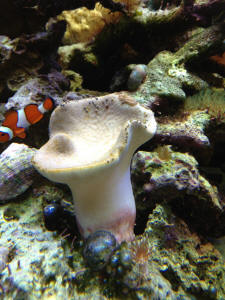
|
|
Sick leather A. Sinularia 9/21/18
Hello crew!
<Hey Cath!>
I've got a leather A. Sinularia that has, up until a couple days ago, been
healthy and happy for the last 3 years. It had three big branches and it's on
one side of the aquarium with not much else around it beyond some Ricordea and
mushroom coral that have been in the vicinity since the aquarium was first set
up. Only recent change was three weeks ago with the addition of a couple snails,
a new pacific cleaner and a small Pocillopora frag that I'd placed on the other
side of my 72G tank. Problem started a few days ago when I noticed once of the
branches didn't seem to be as extended as usual. Took a close look at it today
and there's a couple fingers that have turned dark brown at the tips. One of the
three main
branches has condensed it's size significantly while the second doesn't have
it's polyps extended as normal and has a single brown tip. There's still one of
the three branches that seems 100% healthy and normal.
Initial research online makes me wonder if it's a bacterial infection of some
sort possibly from the most recent introductions.
<Would be my guess too; stress of some sort (chemical, biological, and or
physical) setting off an allelopathogenic reaction... the soft coral losing>
Question is, what's the best way to save it - I've seen suggestions like cutting
any brown tips off and
dipping the coral (in something like Revive). My concern with dipping the coral
is that I'd need to somehow detach the leather from where it's attached to the
wall of the aquarium. I'm worried that may further stress it.
<I share this concern and would not be snipping and dipping just yet. Instead, I
urge you to double to triple dose iodide/iodate w/ whatever preparation you use>
I've also read flow can help and I could possibly reconfigure things so my gyre
pump provides more circulation around it.
<I agree re increased flow>
Even if I can do all of the above, is there something I should be doing to treat
the entire tank?
<The I2 treatment is my "go-to" here>
I have a variety of Euphyllia who at least at this point seem fine but I did
find a dead pulsing xenia which may be related.
<Oh. Yes>
I'm including a couple photos of the coral as well as an overview of the tank
(before it started to get sick)
Once again, I can't thank you guys enough for being here when I've run out of
places to turn for answers.
Cath
<Please do keep me/us informed of developments, your actions. IF it becomes
expedient to snip to outright frag this Sinularia, DO so outside the system, AND
place the specimen in another established tank for recovery for a few weeks. Bob
Fenner>
|
.jpg)
.jpg)
.jpg) |
|
leather toadstool decomposing? 11/26/17
<...18 megs?>
I have had a leather toadstool in my 90 gal reef for years. This past year it
really took off and grew to a height of probably one foot where it reached the
water surface, then started bending over – perhaps to allow further growth. Its
base was 5-6 inches in diameter.
<Mmm; Sarcophytons don't grow to the surface naturally... Something amiss
here... nutrition, water quality, predator, lighting wise... Or?>
Over the past week or so I have seen the skin on the stalk base start sloughing
off and the whole coral is shrinking and getting skinnier. Polyps are not
opening. This seems much different than the top surface thin slime formation I
have read about.
<I agree>
Nothing in my tank has changed. Any suggestions? If you think it is really dying
should I take it out of the tank and try fragging off the top?
<Need more data... the other livestock present, parameters you test for,
supplement habits, foods, feeding. And smaller files going forward. Bob Fenner>
|
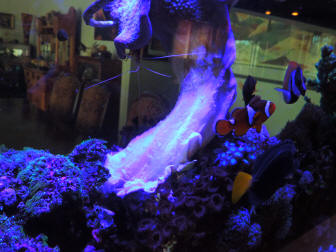 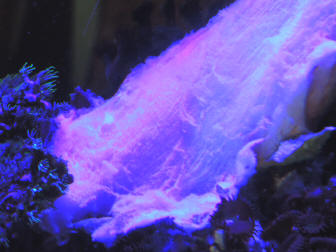
Re: leather toadstool decomposing?
11/27/17
Bob, thanks for rapid reply.
<Welcome Jay>
all other inhabitants- fish ( Foxface, purple tang, clown, orchid Dottyback,
coral beauty),
<Mmm; none of these fishes would tear up an Alcyoniid like this>
Palys , colt coral rock flower anemones, star polyps, Hydnophora,
Kenyan tree, mushrooms all doing well.
<Oh... some of these are/can be very allelopathogenic... There is space
twixt the Zoanthids and Anemones I hope/trust. Do you use chemical
filtrants?>
tank parameters usually
temp - 79
ammonia - 0
nitrites - 0
nitrates- 0
<Mmm; and the lack of NO3 and/or HPO4 can be problematical. All
chemo-photosynthetic life needs some, measurable nitrate, phosphate,
potassium....>
dKH 6-7
calcium - 400-450
<I'd keep under 400 ppm>
salinity- 1.025-26
tank is 90 gal with 15 gal refugium with Chaeto and gets 20 gal water
changes q2wks.
LED lighting unchanged for over one year.
attached are smaller file photos taken today. It looks like the Sarco is
auto-amputating on stalk ??
<... I would likely decapitate this specimen, toss the rest. Do the cutting
OUTSIDE the system, and if at all possible raise the cap or sections thereof
in a different system. Again, I suspect some negative interaction w/ other
stinging-celled life here and likely a matter of degree of nutrient
deprivation as cause/s here>
thanks again ,
js
<Welcome. Bob Fenner>
Re: leather toadstool decomposing?
11/27/17
I have read about fragging Sarcos off the top. it said to do it outside of
aquarium with rinse of new frags in iodine solution water.
I have Kent's Lugol's with info on bottle recommending 40 drops /gal and
immerse for 10-15 min.
<Ok>
I could set up a separate hospital tank after the " decapitation".
If I don't would you place the new shorter Sarco back on same rock or on
tank bottom?
<On some sand substrate in a chemically inert box...>
If I do set up separate tank, assuming new parts look ok and appear to be
growing, how long till I could add back the frags of short Sarco o display
tank?
<A few months likely; far away from other Cnidarians. B>
js
Re: leather toadstool decomposing?
11/27/17
Bob,
also when the Sarco was growing taller and wider all the way to the surface
I thought that meant it was thriving!!
<Nope; as already stated>
|
PowerPoint on Allelopathy 1/18/17
Good evening,
<TT>
I have a green leather toadstool with patches of white opaque areas on
the "face" that the polyps extend out of. It is opening and extending
its polyps as it would normally and seems in good spirits despite the
white patches. My first guess is that it is trying to "shed" as leathers
will do, but I am more concerned for the safety of the other corals in
the tank. If
you upset the leather it can secrete toxins so I want to keep it as calm
as possible. Will send pictures if you like.
<Please do; well cropped... a few hundred Kbytes>
I remember reading that you had a PowerPoint on allelopathy but I can't
find it for the life of me. Would you mind directing me to the link? If
you have any suggested reading for me I would appreciate it. Thank you
so much for your insight and your wonderful website. I've spent
literally hours getting lost here.
<Don't think we have such a ppt... I put away most all... and have for
twenty years.>
S pozdravem / Best regards,
Taylor Thrasher
<I suspect you're right re the Sarcophyton shedding... which they do
almost continuously, then shed a bunch at times. I encourage you to
triple dose iodide-ate, turn up your circulation, aeration; refresh you
chemical filtrants (Chemi-Pure and PolyFilter are faves here... and keep
your eyes on your other livestock for signs of stress. Bob Fenner>
Toadstool Problem?? 9/13/15
Hey, I have a Green polyp Toadstool leather (been in tank 2wks.), It is in my
180 w/ 30 Gal Sump, water parameters reading:
Ammonia 0
Nitrates 0
<Uhhh....>
Nitrites 0
Phosphates 0
<And this; necessary. SEE/READ on WWM Re>
Salt 1.023
<Too low>
Temp 78F
Tank has been up and running for 2 months
<Too soon>
Its under 3 AI Sol Blue the run about 8hrs. Daytime Lights only go up to about
30%
<Blue are worthless functionally>
Flow is moderate to high w/ 2 Vortech MP40 at end of tank
I bought Plug at Petco and it was blowing it the flow nicely at the store.
First day it was slumped over in my tank but the next day it had perked up back
straight. since then…In the morning when the lights come on it expands its
polyps for a few hours then it retracts them for the rest of the day (around
noonish). It has been doing this for the past week and half.. I have read that
it might be trying to shed but it doesn't have a waxy/shiny coating. I do have a
4” wall hammer frag about 10” away?
<S/b fine>
I feed fish a lot, since Lamarks angel likes to eat all the time
<Good>
I though about my crab but haven’t witnessed them munching out.
Since this behavior of the leather is repeated every day I thought maybe
lighting?
<Not likely>
maybe flow? maybe shedding? or just give it time to adjust to its new home? If
so, how long?
<Nutrition>
Thanks for the help
April
<The reading. Bob Fenner>
|
Toadstool Mushroom
– 06/18/14
Dear WWM Crew,
First off, I’d like to say thanks for all the awesome info that you
provide. Its been an invaluable resource for me and my aquariums over
the last four years.
<Ah good>
I wanted to see if you could help answer a question regarding my
Toadstool Mushroom Coral (Sarcophyton). I got this from LiveAquaria over
3 years ago and at the time the cap was around 2”. Since then it has
dramatically changed as it has grown up to its current 20-24” size.
About 6 months ago I moved it into a 220 FOWLR/mixed reef tank where it
currently resides. It was previously in a 125 FOWLR.
<I see your pix of this animal>
When I moved it into the 220, I also upgraded the lighting from 4 X 80W
T5s to 3 Rapid Led Onyx Fixtures hung 10” over the tank. Also, I added
some additional flow with an MP40 (I also have an MP60 which was also on
the 125).
Over the last 4 months, it has changed from a gold color with long
extended polyps to a blue-greenish color with little to no polyps
extended. It also tends to “close up” or “scrunch up” more so now that
it did in the past. I attached a photo of what it currently looks like
along with some of what it looked like in the past. I guess I’m
wondering if this is normal behavior for the coral.
<Something "normal" given the changes you detail in the lighting, move.
This specimen appears starved to me>
Could it possibly be receiving more energy or nutrients from the
brighter lighting?
<Mmm; possibly... but perhaps there's less nutrient to go around in this
new setting. DO you have measurable NO3 and HPO4? >
Could the increased flow also be a factor in the polyp extension?
Please let me know as I really enjoy this coral and want to make sure
there isn’t something seriously wrong.
Thanks,
Michael Schmidt
<Need your nutrient measures... what specifically do you feed it, your
system? How much and how often? Do you utilize chemical
filtrants? Bob Fenner>
|
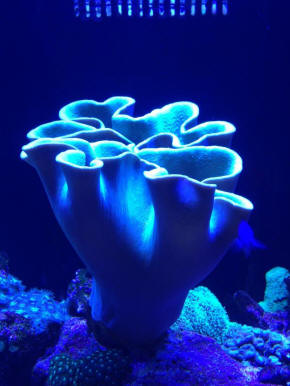
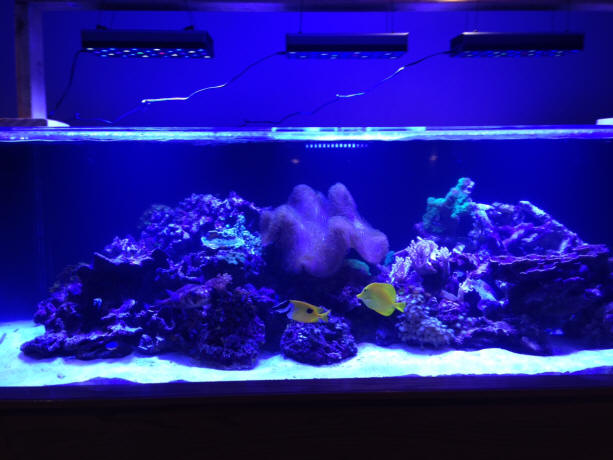
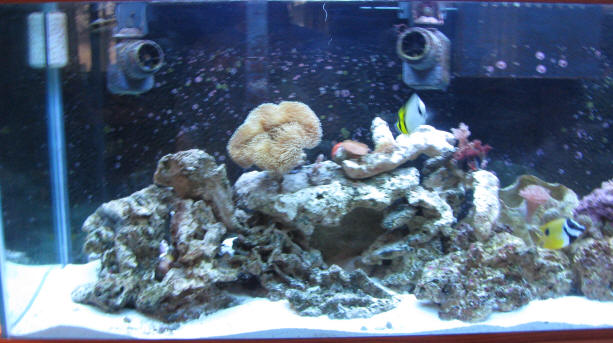 |
|
Re: Toadstool Mushroom
– 06/19/14
Bob,
I'm honored by your fast reply. I love your books, articles, and email
responses by the way.
<Thank you for your kind words>
As far as feeding goes: I think it should be getting "some" nutrients. I
have a pretty high fish load - porcupine puffer, harlequin tusk,
foxface,
yellow tang, small hippo tang, flame angel, along with quite a few
various
damsels and everything's healthy although I have had some Ich outbreaks
in the past before I setup a QT. I also have quite a few soft corals
<Yes; to the right of the Sarco... Lemnalia? Another softie; perhaps a bit
of allelopathy going on>
and
a few Montipora corals which seem to be doing good & growing. I feed
small
amounts of various pellet food on an auto-feeder 2X daily and also feed
frozen (usually various rod's foods, shrimps, scallops, clams) 4x/week
and
Nori/macro 1-2X/week.
As far as measurables go: I just tested and my levels are as follows:
Phosphate .04 (this has been steadily dropping over the last 3
months from .15 as I added a GFO reactor as part
of the upgrade to the 220 - could this drop be the
problem?),
<Yes indeed. I would turn off for now>
and Nitrate 10-15 PPM which is a best guest with a
color test kit (usually its around 5-10). 8 dKH (usually 6-8), Ca 420
(usually 400-420), Mag 1365 which are at/near my goal levels b/c I just
dosed alk/ca a few days ago.
For chemical filtrants: I run a cup or 2 of carbon in a 7" filter sock
changed
once per week.
<Fine>
I run a bio-pellet reactor w/ 2-3 cups of pellets that feeds
into a large Reefoctopus skimmer.
<Fine as well>
In addition to those I run a UV ( I know, I
know but they seem to work well together), a 40 gallon Chaeto/DSB fuge,
and
the previously mentioned GFO reactor which all output to the return pump
intake. This is all in a 125 baffled sump. Last but not least, there's
about 275 lbs of live rock throughout the whole system.
I'm pretty diligent with maintenance, changing 28 gallons every Thursday and
testing/dosing every Sunday. Overall its pretty clean & nuisance free
but when doing weekly water changes, I still need to
clean algae from the sides & gravel vac the sand bed (which gets a
little brown algae growing on it) to keep it looking good. I'm guessing this
is normal when the CUC consists of myself and a few urchins.
<A worthy team>
Hopefully this all sheds some light.
Funny thing is that this coral looked "normal" since the beginning when I
didn't really know what I was doing and now that I think I have a handle on
the hobby, it starts to look "weird". I know I've made a lot of changes
since the upgrade and there are a lot of moving parts (lighting, flow,
chemicals, and nutrient levels) that it can be hard to pinpoint the problem
but what would be your best guess as to why it has very little polyp
retraction and a change in coloration?
<Could be many factors... best to proceed slowly>
One last thing I just thought of, when it does show polyp extension (they
stick out 1/4" at most), it usually happens at dusk/dawn when my blue lights
are brighter than my whites. They are controlled with an ALC module to ramp
up to 80% with the blues being on for around 10.5 hours and the whites on
for 9. I rarely see any polyp extension at night.
<Often the behavior of nocturnal-active organisms gets reversed under
captive conditions... when food is available, and no real predators and
pests as in the wild>
Thanks so much,
Michael
<Ah, welcome. BobF>
|
|
Cauliflower colt coral (Alcyonium?) - brown slime trails and
shrinkage
10/27/13
<Has the net gone crazy. Your email should have been sent to junk for
being too large a file size.>
Hello WWM team!
Five days ago we introduced to our 55-Gal display tank
a soft coral (what we believe to be cauliflower colt coral [Alcyonium?]
- slimy, not leathery).
It seemed to be adjusting to its new home quite well for several days,
but then yesterday it shriveled up a bit, then opened back up and today
is shriveled for the most part and streaming brown slime from one side.
We have been reading, consulted LFS, and have received conflicting/mixed
information; would appreciate your input as we trust it most.
This coral was imported to our LFS from the wild. Its flat base rock had
broken (perhaps some tearing hidden underneath that we cannot see?) -
this was approximately at the same place as where the two major branches
are barely connected. We acclimated using the bag method (accidentally
dumping approx. 2-3 cups of the first mix of water into our system -
oops!), followed by a dip in TwoLittleFishes ReVive Coral Cleaner
(smells like Pine Sol)
<For good reason>
for over 5 minutes with fairly constant gentle movement. We then placed it
with some difficulty, so it was moved around a lot before we finally got
it puttied down in a fairly prominent location, close to the middle of
the tank in medium water-flow.
We haven't noticed any of the fish nipping at it (2 Ocellaris anemone
fish, 1 blue-faced comb-toothed blenny, and a blue-green Chromis). We
also haven't noticed any crabs coming up to check it out (though we do
have a good-sized
Mithrax rock crab - little grey tank of a critter with meaty fists and
red eyes- that we have been unable to catch to date). We do have a large
resident eunicid worm, but in another rock on the other side of the
tank, not within reach. We do not have a lot of corals for there to be
mega chemical warfare floating around in the water (only some
yellow polyps that we purchased, plus hitchhikers including many brown
polyps, some green polyps and what appears to be a nice patch of a hard
carpet - all of these are over 8" away from this one, and all small in
comparison).
Running with the 55-Gal display tank, we have a canister filter and an
approx. 15-Gal modular sump with small refugium area (live rock and
macroalgae) in the middle and a fairly hefty fractionator. To mix our
water, we use tap water treated with Prime, with H2OceanPro salt mix
using a power head for at least a day.
<Good; longer would be better>
Test results today are as follows, (We just bought the iodine test today
when we went to discuss the issue with the LFS as we didn't already have
one
- it seems odd that it would be zero when sufficient iodide/iodate are
supposed to be present in saltwater mixes):
Temp 82
Salinity 1.024
pH 8.2
NH3/NH4+ 0
NO2- 0
NO3- 0
<.... see WWM re... chemo-photo-synthetic life needs appreciable
nitrate, phosphate, potassium....>
KH 8
Ca2+ 320
Mg 1000
K
380
PO4 0
<See above>
Iodide 0
Iodate 0
We are currently supplementing Potassium and Magnesium to get
them up to their appropriate ranges (then will be using Kalkwasser to
help with Calcium).
<You are adding these to your change out water I hope/trust; not
directly to the system water>
Lighting is a 4-light 48" T5 canopy - two 14K on the daylight cycle (8.5
hours) and one Fiji Purple and one Actinic on the dusk and dawn cycle
(12 hours).
Some of the conflicting reasons as to why this poor coral might
appear to be struggling included these:
1) Meltdown due to lack of
iodide/iodate.
<Possibly; but more likely allelopathy>
2) LFS advised likely parasitic worms and
recommended dipping every 2-3 days for 2 weeks.
<No; and don't do this>
3) Separation between the two branches
sufficient for the animal to become two, thus warring with one another.
<No; genetically identical, not "seen" as enemy>
4) Sloughing slime to create a new coat;
normal activity.
<To some degree; yes>
5) Just needing more time to adjust.
<And this>
Your thoughts will be much appreciated!
<See WWM re the comments made above (NO3, HPO4, Alcyonacean
Allelopathy...) and in future, hundreds of Kbytes, NOT 10 plus Megs>
Thanking you in advance,
Guy & Heide
<Welcome, Bob Fenner>
|
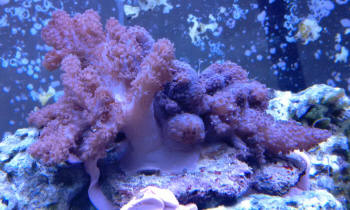 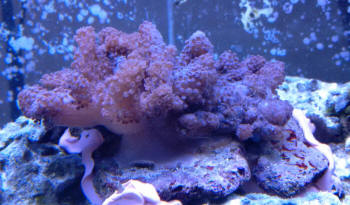 |
|
Leather coral not opening – 09/9/13
Do these look like fish bites or something else?
<Mmm, can't make out much... but don't look "bitish" to me. Bob Fenner>
Adam
|
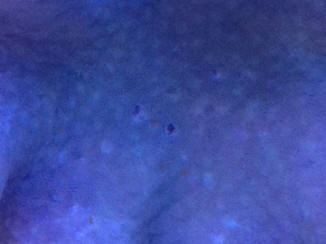 |
Re: Leather coral not opening
– 09/9/13
What could make little circular holes like that?
<The polyps themselves most often... Something malaffecting them;
usually water quality related, allelopathogenic second as common cause...
See WWM re Alcyoniids, Health, Systems... BobF>
Adam |
|
Tyree Leather Question; ID, hlth. 9/6/13
Hi there,
<JR>
First to start, I was told when I purchased this toadstool it was a
Tyree Neon Green Leather. I have attached photos, do you believe it is
indeed?
<Will have to guess what you're after here... Was SteveT paid
some money, or paid himself some for lending his appellation to
this sort of phenotype Alcyonacean? Can't tell from here. Could be>
I have looked at others online and notice slight variations in the polyps.
<Oh! There's all sorts of dissimilarity here to be expected; due to
recent experiences, conditions in locus>
Are others mis-classifying similar leathers?
<Doubtless; consciously and not>
Or was mine mis classified. I only have one not great picture of it when
it was open.
<See it/this>
The real question is should I worry it has been closed for 3
days.
<Oops; have you read on WWM re such? I would... Alcyoniid beh. FAQs>
The other corals
<... Umm, and re Allelopathy... how was this animal
introduced here? Read on!>
I have (all on separate rocks) are open and healthy. When I was attaching
the frag, I unfortunately had to touch the leather a few times.
The first day, it was on the sandbed
<.... this species grows attached to rock; not on substrates>
opening within 20 minutes, after attaching on day 2 it closed and hasn't
reopened. Is it just reacting, possibly shedding from handling? Does it
still look healthy despite being closed?
<Macroscopically (which doesn't count for much); yes>
My parameters are:
Nitrate- undetected
<Uhh, keep reading... All chemo-autotrophs need measurable NO3, HPO4 and
more... Something the folks making the big bongo bucks selling
novices chemical filtrants, gear seem to want to neglect mentioning.>
Nitrite- undetectable
KH- 180-200 on strip test
PH- around 8
Salinity-1.026
Thanks for your time
JR
<You'll thank me/use much more after reading, more fully understanding
what's going on here; and better, what can be done to "make things
better".
Bob Fenner>
|
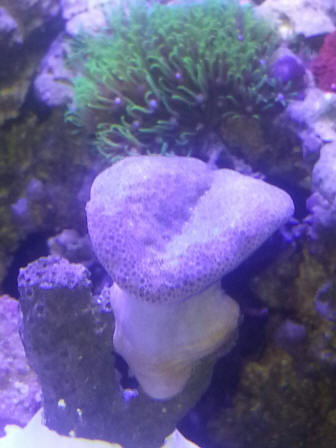 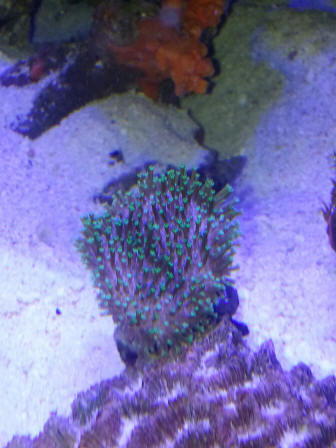
Do you see what I see? |
Re: re: Tyree Leather Question
9/6/13
Ah my mistake. I know Steve Tyree has his name attached to many things in
this industry, but I thought Tyree green toadstool was a specific name for a
specific type of toadstool.
<Likely is; I don't know what is meant by "specific type"... Have seen
something similar listed as "ORA" "type">
In my reading over the past few days I have seen that leathers are usually
the aggressor, or at least the victor in chemical battles.
<Indeed they are; though all such life wars in various ways, degrees>
I thought this could be the issue so I did a water change yesterday and
I run activated carbon, but I can change it out just incase.
I have also read that toadstools will cover themselves with a mucus or waxy
like substance from time to time.
<Kind of a continuous behavior... build-up, and shedding>
There seems to be some debate as to what exactly this is a response to. I
didn't have much time to get my baseline observation of how mucus covered or
wax covered it appeared while it was open, so I don't know if this is one of
those cases. I had hoped it would come through in the pictures I sent, all I
have is my camera phone and it always wants to focus on the glass specks and
not the corals.
<Heeee!>
I introduced the toadstool by float method over approximately 25 minutes.
<... please read where you were referred to... this SOP is NOT useful for
mixing Cnidarians>
I also introduced an Australian hammer coral over the same period. Both
corals are approximately 1 inch diameter. The toadstool being 1.5 to 2
inches tall. The hammer is doing great.
<Euphylliids/Caryophylliids generally "rank higher" on/in allelopathogenic
rankings/battles>
I have green star polyps, orange and green Zoas, green
Zoas,
<... and see WWM re these, Compatibility FAQs>
the toadstool and hammer coral, and 2 trumpet corals. I have read Zoas can
sting touching corals, but are they usually a threat via water column?
<Can definitely be>
Also, none of the corals touch or are even on the same rock.
<Doesn't exclude their negative interacting>
I also have a healthy maxima clam. A yellow watchman goby, and paired tomato
clowns.
I realize it isn't a perfect world where you can just tell me the
exact answer, but should I remove a coral, change my carbon, or
just wait and see.
<To read. B>
Thanks again,
JR |
Yellow Fiji Coral... hlth., no data 5/11/13
I am having a problem with my yellow Fiji coral.
<...? Sarcophyton elegans? This soft coral is a poor survivor in most
hobbyist settings>
I noticed a film on it thought it was shedding like most leathers do and
blew the film off and when I did it opened up two huge holes in it.
<Mmm, likely a predator or two at work here... do "dig around" the wound
sites... for mollusks and worms... And see WWM re (Errantiate
Polychaete/Bristle) control (baiting/trapping/removal>
One on the base and one on the cup of it. I want to save this coral if at
all possible. Thank you for any advice
<... search for all on WWM. Bob Fenner>
Re: Yellow Fiji Coral
5/11/13
No pred.s in the tank
<... likely there are... again, try a baited trap, at night>
the tank is 8 years old...I have a clown and a damsel in there and snails
and yes it is a Sarcophyton Elegans. I have searched your website
over that is why I finally emailed you....we treated for dino last week
so it had no lights for 3 days but I kept an eye on the param.s and when
we finally uncovered the tank and turned the lights on It was still
bright and yellow.
<... well; the holes could be from other cause/s... Need data re the
other livestock, mechanicals/controllers, water quality tests... Perhaps
allelopathy or a chemical over-under imbalance... B>
Purple finger coral, hlth. 2/7/13
Bob, My Mother gave me a purple finger coral.
<The soft coral?>
It has never done anything for her so she gave it to me. Now the problem
is she glued to a piece of live rock. That's why I think it has never done
anything. I took a chisel and hammer and broke the live rock in pieces and moved
the coral to the bottom of my tank. Do you think because she glued the bottom
its toast?
<No; this Alcyoniid is tough, easily fragged>
Has not done nothing yet.
<... see, read on WWM re health>
Thanks! P.s. The fish store believe or not is taking the elegance
back.
<Ah good. Bob Fenner>
|
Finger leather disease
12/20/12
Something seems to be eating my finger leather it is like a black web.
<Does appear to me as well>
I noticed it first on one of the fingers and have since removed it and
recently rotated the piece to discover that whatever it is has made a big
dent in the base as seen here.
<Mmm, could be worm/s, a type of Mollusc, even some fishes will chew a hole
like this>
Given your experience would it be best to frag the healthy fingers off,
attempt to treat it, or attempt to cut off the dying chunk in the base?
<A part of the base is best... In this case, just cutting the animal above
the chewed, damaged area, using an iodide-ate dip/bath, tying the
Alcyonacean down to a hard/rock base, per what is posted on fragging/asexually
reproducing soft corals on WWM. Bob Fenner>
<Of course, you need to determine the cause/source of the damage and
correct/remove it>
|
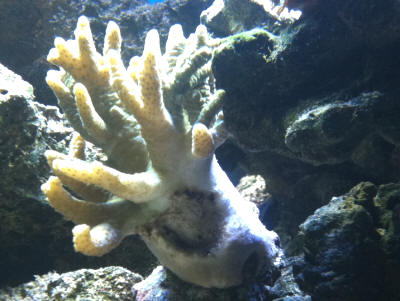 |
Re: Finger leather disease
12/22/12
On that note I have a bit of a strange question. I have not had much
success with iodine dips before and happen to have a ton of ground kelp
sitting around the house which dissolves in water and is rich in iodine.
<Interesting... in our town (San Diego), was a company (Kelco) that has
traded hands quite a few times... that extracts alginates (emulsifiers)
from some of the large Phaeophytes (brown kelps/algae) harvested off the
coast... I don't know http://en.wikipedia.org/wiki/Iodine that Iodine
(actually iodide) is collected in the process, but it can be
(http://en.wikipedia.org/wiki/Iodine )...>
I'm wondering if I mix kelp into a container with the water and keep the
coral in that water for a bit whether it would have the same or similar
effect. The damage seems to be increasing and I have not observed
anything in the tank biting the coral so I suspect it is some kind of
fast acting algae or fungus.
<I would get/use a commercial prep. I am particularly fond of the
SeaChem line (real products en toto, consistent in make-up)...
Iodide-ate is very safe used as directed. Bob Fenner> |
|
Leather Pests? 4/17/12
Hi WWM,
<Amy>
We woke up this morning to find our leather closed up and these little
spiked things sticking up all over on it!
<Bizarre!>
I've been trying to search all morning to find out what they are but I've
had no luck!
They don't seem to be moving and are small, probably a few millimeters in
length only. I've attached a photo for you!
Hope this is something you've seen before and can tell me what I should try
to fix the problem!
Thank you!
Amy :)
<Due to their sudden appearance and distribution, am guessing these are part
of the soft coral itself... some sort of reaction to... another Cnidarian?
Water quality change? I'd be changing out a good deal of the water, possibly
utilizing carbon... and reading here:
http://www.wetwebmedia.com/AlcyDisF15.htm
Was another stinging-celled life organism added recently? Showing a
difference in appearance, behavior?... It may need to be removed,
re-acclimated... Search WWM re allelopathy. Bob Fenner>
|
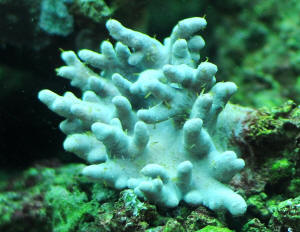
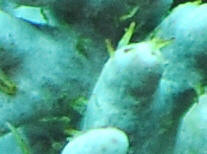 crop
crop |
|
Toadstool leather coral, likely allelopathy
2/9/12
Recently (the past 2 weeks) my toadstool will not
straighten..
<5 megs...... what is the blue organism next to this
Sarcophyton?>
I've had him for a little over 4 months.. now I know this is
normal (according to info from your site) if it is
"molting" or parameters have changed in the tank. My
parameters have not changed, but today when I was taking a close
look I noticed this nodule on the side of the stalk. my question
is, is it possible its growing a new head... if not any
suggestions on what it may be..
David
<... read here: http://wetwebmedia.com/AlcyDisF14.htm
and the linked files above. Bob Fenner>
|
|
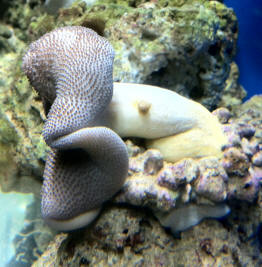
|
Poorly Toadstool 1/6/12
Hi Guys,
<Hello George>
can you give me some advise please. I have a Toadstool coral that has
recently developed a yellowish area on it. All my water conditions are
fine. I have only had a marine tank for 6 months. I have a few hermit
crabs, a sand sifting star fish and a couple of snails. The coral had
been in the tank for about 3 months. It seems ok apart from the yellow
colour which has appeared. It looks like a bit of yellow dust. It is
only on a small area. Any advise or suggestions would be most
welcome.
<This Sarcophyton species, providing conditions are present for
it's survival, is likely shedding and
will usually change to a slightly darker color in the early stages of
shedding. During this process the polyps will not open and it will
appear as if it is dying but it's not.
Two weeks is generally the norm for this process to complete but can
take longer. You may want to take a turkey baster and blow water across
the yellowish area just to be sure it's not debris or waste of some
kind.
May want to read FAQs here and related FAQs found in the header
regarding Sarcophyton health.
http://www.wetwebmedia.com/alcyondisfaq4.htm>
thanks
<You're welcome. James (Salty Dog)>
George
|
Help infected toadstool!! 12/19/11
Hi,
<Scott>
I'm trying to get some help for my toadstool.
Water parameters ( 76degrees, pH8.25, SG1.025, Alk 3.4 , calcium
420, mg 1380, n03 2.5, po4 .03 ) And I have a reef octopus
skimmer running 24/7.
<Ok>
The toadstool has adequate current and is usually happy as a
clam! ( or a toadstool)
This past week it closed up and I figured it may just be getting
ready to molt like they do. This time there was no sloughing off
of the outer layer of skin and a patch of brown mucous formed in
the back right area of the head (see picture).
<Mmm, yes; looks like an injury due to a bite>
The mucous has a white ring around it. I'm thinking
infection. All the other toadstools in the tank are happy. If it
is infected should I take it out and quarantine ? Iodine dip?
<At least increased addition of iodide/ate>
Also I'm not sure if it makes a difference but the toadstool
has hosted a clownfish for the last 4 years. Could the fish
rubbing have caused this?
<Mmm, only if the Sarcophyton was compromised... which there
is evidence of at the base. I'd be removing the Aiptasia and
likely the Valonia here. Bob Fenner>
Help!
Scott Cooke
|
|
 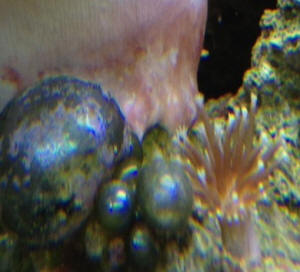
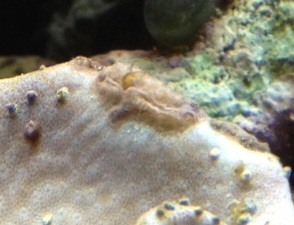
|
Re: Help infected toadstool!! 12/19/11
Hi again Bob,
<Scott>
The Aiptasia you are seeing at the base is actually
another toadstool that the main one dropped as it moved across
the rock.
<Really? Do expand this image and look again please. I have
done so (posted on WWM's dailies in a bit) and see something
w/ tentacles unlike an Alcyoniid>
It has split 5 little ones off of it's foot as it has moved
over the years.
The darker coloration at the base is just that
(coloration), no algae. It has always been there.
<Okay>
With those out of the picture it is just the wound on the
crown.
<Mmm, this I wouldn't over-react to.>
Would dosing the tank with iodine hurt anything else in the
tank?
<No; it will not, but not iodine... Wrong valence state for
this element.
Please read Marco's piece here re:
http://www.wetwebmedia.com/IodineSWArt.htm
and the linked files above>
I have tons of sps, lps, anemones, Zoas, and other softies.
I'm a little reluctant to put anything that isn't natural
into the tank.
Thanks,
Scott
<And I'd daub a concentrated bit (on a cotton swab,
underwater) directly onto the "sore" area on the
Sarco's crown. BobF>
|
Re: Help infected toadstool!! --
12/19/11
Here is a close up photograph of the small sacro baby I was
describing at the base. Are we talking about the same
thing?
<Yes; and does appear to be a small Alcyoniid>
Also, attached is a more close up picture of the
"sore" area.
<Mmm, what is that brown bit rising up? Perhaps a
Hydrozoan... Again, I would "stick" this area w/
an iodide/ate prep.>
I will look into dosing the tank. Thank you for the iodine
site link, I learned a lot from that page!
Thanks!
Scott
<Thank you. BobF>
|
|
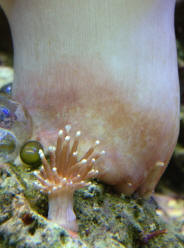 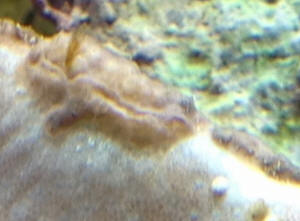
|
|
|
|

